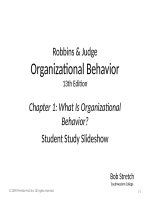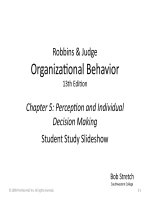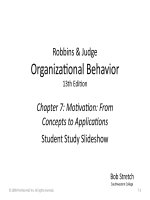Slide OB 13e chapter 04 personality and values
Bạn đang xem bản rút gọn của tài liệu. Xem và tải ngay bản đầy đủ của tài liệu tại đây (128.2 KB, 29 trang )
Robbins & Judge
Organizational Behavior
13th Edition
Chapter 4: Personality and Values
Student Study Slideshow
Bob Stretch
Southwestern College
© 2009 Prentice-Hall Inc. All rights reserved.
4-1
Chapter Objectives
• After studying this chapter, you should be able to:
– Define personality, describe how it is measured, and explain the
factors that determine an individual’s personality.
– Describe the Myers-Briggs Type Indicator personality framework
and assess its strengths and weaknesses.
– Identify the key traits in the Big Five personality model.
– Demonstrate how the Big Five traits predict behavior at work.
– Identify other personality traits relevant to OB.
– Define values, demonstrate their importance, and contrast
terminal and instrumental values.
– Compare generational differences in values, and identify the
dominant values in today’s workforce.
– Identify Hofstede’s five value dimensions of national culture.
© 2009 Prentice-Hall Inc. All rights reserved.
4-2
What is Personality?
The dynamic organization within the individual of
those psychophysical systems that determine his
unique adjustments to his environment. - Gordon
Allport
– The sum total of ways in which an individual reacts and
interacts with others, the measurable traits a person
exhibits
•Measuring Personality
– Helpful in hiring decisions
– Most common method: self-reporting surveys
– Observer-ratings surveys provide an independent
assessment of personality – often better predictors
© 2009 Prentice-Hall Inc. All rights reserved.
4-3
Personality Determinants
• Heredity
– Factors determined at conception: physical stature,
facial attractiveness, gender, temperament, muscle
composition and reflexes, energy level, and biorhythms
– This “Heredity Approach” argues that genes are the
source of personality
– Twin studies: raised apart but very similar
personalities
– Parents don’t add much to personality development
– There is some personality change over long time
periods
© 2009 Prentice-Hall Inc. All rights reserved.
4-4
Personality Traits
Enduring characteristics that describe an
individual’s behavior
– The more consistent the characteristic and the
more frequently it occurs in diverse situations, the
more important the trait.
• Two dominant frameworks used to describe
personality:
– Myers-Briggs Type Indicator (MBTI®)
– Big Five Model
© 2009 Prentice-Hall Inc. All rights reserved.
4-5
The Myers-Briggs Type Indicator
• Most widely-used instrument in the world.
• Participants are classified on four axes to
determine one of 16 possible personality
types, such as ENTJ.
– Extroverted (E) vs. Introverted (I)
– Sensing (S) vs. Intuitive (N)
– Thinking (T) vs. Feeling (F)
– Judging (J) vs. Perceiving (P)
© 2009 Prentice-Hall Inc. All rights reserved.
4-6
The Types and Their Uses
• Each of the sixteen possible combinations has a name,
for instance:
– Visionaries (INTJ) – are original, stubborn and driven.
– Organizers (ESTJ) – realistic, logical, analytical and
businesslike.
– Conceptualizer (ENTP) – entrepreneurial, innovative,
individualistic and resourceful.
• Research results on validity mixed.
– MBTI® is a good tool for self-awareness and counseling.
– Should not be used as a selection test for job candidates.
© 2009 Prentice-Hall Inc. All rights reserved.
4-7
The Big Five Model of Personality
Dimensions
•
•
•
•
•
Extroversion
– Sociable, gregarious, and assertive
Agreeableness
– Good-natured, cooperative, and trusting
Conscientiousness
– Responsible, dependable, persistent, and organized
Emotional Stability
– Calm, self-confident, secure under stress (positive), versus
nervous, depressed, and insecure under stress (negative)
Openness to Experience
– Curious, imaginative, artistic, and sensitive
© 2009 Prentice-Hall Inc. All rights reserved.
4-8
How Do the Big Five Traits Predict
Behavior?
• Research has shown this to be a better framework.
• Certain traits have been shown to strongly relate to
higher job performance:
– Highly conscientious people develop more job knowledge,
exert greater effort, and have better performance.
– Other Big Five Traits also have implications for work.
• Emotional stability is related to job satisfaction.
• Extroverts tend to be happier in their jobs and have good social
skills.
• Open people are more creative and can be good leaders.
• Agreeable people are good in social settings.
See Exhibit 4-2
© 2009 Prentice-Hall Inc. All rights reserved.
4-9
Other Personality Traits Relevant to
OB
• Core Self-Evaluation
– The degree to which people like or dislike themselves
– Positive self-evaluation leads to higher job performance
• Machiavellianism
– A pragmatic, emotionally distant power-player who believes that ends
justify the means
– High Machs are manipulative, win more often, and persuade more
than they are persuaded. Flourish when:
• Have direct interaction
• Work with minimal rules and regulations
• Emotions distract others
• Narcissism
– An arrogant, entitled, self-important person who needs excessive
admiration
– Less effective in their jobs
© 2009 Prentice-Hall Inc. All rights reserved.
4-10
More Relevant Personality Traits
• Self-Monitoring
– The ability to adjust behavior to meet external,
situational factors.
– High monitors conform more and are more likely to
become leaders.
• Risk Taking
– The willingness to take chances.
– May be best to align propensities with job
requirements.
– Risk takers make faster decisions with less
information.
© 2009 Prentice-Hall Inc. All rights reserved.
4-11
Even More Relevant Personality Traits
• Type A Personality
– Aggressively involved in a chronic, incessant struggle to achieve
more in less time
•
•
•
•
Impatient: always moving, walking, and eating rapidly
Strive to think or do two or more things at once
Cannot cope with leisure time
Obsessed with achievement numbers
– Prized in North America, but quality of the work is low
– Type B people are the complete opposite
• Proactive Personality
– Identifies opportunities, shows initiative, takes action, and
perseveres to completion
– Creates positive change in the environment
© 2009 Prentice-Hall Inc. All rights reserved.
4-12
Values
Basic convictions on how to conduct yourself or how to
live your life that is personally or socially preferable –
“How to” live life properly.
•Attributes of Values:
– Content Attribute – that the mode of conduct or end-state
is important
– Intensity Attribute – just how important that content is.
•Value System
– A person’s values rank-ordered by intensity
– Tends to be relatively constant and consistent
© 2009 Prentice-Hall Inc. All rights reserved.
4-13
Importance of Values
• Provide understanding of the attitudes,
motivation, and behaviors
• Influence our perception of the world around
us
• Represent interpretations of “right” and
“wrong”
• Imply that some behaviors or outcomes are
preferred over others
© 2009 Prentice-Hall Inc. All rights reserved.
4-14
Classifying Values – Rokeach Value
Survey
• Terminal Values
– Desirable end-states of existence; the goals that a person
would like to achieve during his or her lifetime
• Instrumental Values
– Preferable modes of behavior or means of achieving one’s
terminal values
• People in same occupations or categories tend to hold
similar values.
– But values vary between groups.
– Value differences make it difficult for groups to negotiate
and may create conflict.
See Exhibits 4-3 and 4-4
© 2009 Prentice-Hall Inc. All rights reserved.
4-15
Generational Values
Cohort
Entered
Workforce
Approximate
Current Age
Dominant Work Values
Veterans
1950-1964
65+
Hard working, conservative,
conforming; loyalty to the
organization
Boomers
1965-1985
40-60s
Success, achievement, ambition,
dislike of authority; loyalty to career
Xers
1985-2000
20-40s
Work/life balance, team-oriented,
dislike of rules; loyalty to
relationships
Nexters
2000-Present
Under 30
Confident, financial success, selfreliant but team-oriented; loyalty to
both self and relationships
See Exhibit 4-5
© 2009 Prentice-Hall Inc. All rights reserved.
4-16
Linking Personality and Values to the
Workplace
Managers are less interested in someone’s ability
to do a specific job than in that person’s
flexibility.
•Person-Job Fit:
– John Holland’s Personality-Job Fit Theory
• Six personality types
• Vocational Preference Inventory (VPI)
– Key Points of the Model:
• There appear to be intrinsic differences in personality
between people.
• There are different types of jobs.
• People in jobs congruent with their personality should be
more satisfied and have lower turnover.
© 2009 Prentice-Hall Inc. All rights reserved.
4-17
Holland’s Personality Types
• Six types:
–
–
–
–
–
–
Realistic
Investigative
Artistic
Social
Enterprising
Conventional
• Need to match personality type with occupation
See Exhibits 4-7 and 4-8
© 2009 Prentice-Hall Inc. All rights reserved.
4-18
Still Linking Personality to the
Workplace
In addition to matching the individual’s personality to
the job, managers are also concerned with:
•Person-Organization Fit:
– The employee’s personality must fit with the
organizational culture.
– People are attracted to organizations that match their
values.
– Those who match are most likely to be selected.
– Mismatches will result in turnover.
– Can use the Big Five personality types to match to the
organizational culture.
© 2009 Prentice-Hall Inc. All rights reserved.
4-19
Global Implications
• Personality
– Do frameworks like Big Five transfer across cultures?
• Yes, the but the frequency of type in the culture may vary.
• Better in individualistic than collectivist cultures.
• Values
– Values differ across cultures.
– Hofstede’s Framework for assessing culture – five value
dimensions:
•
•
•
•
•
Power distance
Individualism vs. Collectivism
Masculinity vs. Femininity
Uncertainty Avoidance
Long-term vs. Short-term Orientation
© 2009 Prentice-Hall Inc. All rights reserved.
4-20
Hofstede’s Framework: Power
Distance
The extent to which a society accepts that
power in institutions and organizations is
distributed unequally.
• Low distance
• Relatively equal power between those with status/wealth and
those without status/wealth
• High distance
• Extremely unequal power distribution between those with
status/wealth and those without status/wealth
See Exhibit 4-6
© 2009 Prentice-Hall Inc. All rights reserved.
4-21
Hofstede’s Framework: Individualism
• Individualism
– The degree to which people prefer to act as
individuals rather than as members of groups
• Collectivism
– A tight social framework in which people expect
others in groups of which they are a part to look
after them and protect them
© 2009 Prentice-Hall Inc. All rights reserved.
4-22
Hofstede’s Framework: Masculinity
• Masculinity
– The extent to which the society values work roles
of achievement, power, and control, and where
assertiveness and materialism are also valued
• Femininity
– The extent to which there is little differentiation
between roles for men and women
© 2009 Prentice-Hall Inc. All rights reserved.
4-23
Hofstede’s Framework: Uncertainty
Avoidance
The extent to which a society feels threatened
by uncertain and ambiguous situations and
tries to avoid them
– High Uncertainty Avoidance:
• Society does not like ambiguous situations and tries to
avoid them.
– Low Uncertainty Avoidance:
• Society does not mind ambiguous situations and
embraces them.
© 2009 Prentice-Hall Inc. All rights reserved.
4-24
Hofstede’s Framework: Time
Orientation
• Long-term Orientation
– A national culture attribute that emphasizes the
future, thrift, and persistence
• Short-term Orientation
– A national culture attribute that emphasizes the
present and the here-and-now
© 2009 Prentice-Hall Inc. All rights reserved.
4-25









